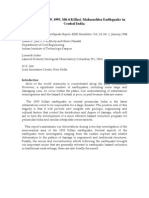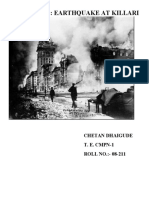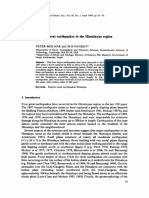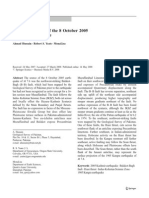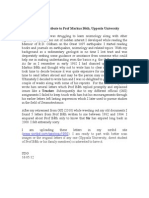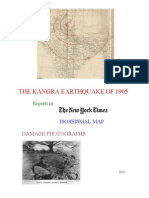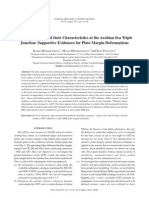Revisiting Two Indian Earthquakes of 1885
Revisiting Two Indian Earthquakes of 1885
Uploaded by
Sujit DasguptaCopyright:
Available Formats
Revisiting Two Indian Earthquakes of 1885
Revisiting Two Indian Earthquakes of 1885
Uploaded by
Sujit DasguptaCopyright
Available Formats
Share this document
Did you find this document useful?
Is this content inappropriate?
Copyright:
Available Formats
Revisiting Two Indian Earthquakes of 1885
Revisiting Two Indian Earthquakes of 1885
Uploaded by
Sujit DasguptaCopyright:
Available Formats
JOURNAL GEOLOGICAL SOCIETY OF INDIA
Vol.93, March 2019, pp.263-268
Revisiting Two Damaging Indian Earthquakes of 1885: Kashmir
and Bengal
Sujit Dasgupta1 and Basab Mukhopadhyay2*
1
Formerly at Geological Survey of India,
2
Geological Survey of India, Map and Cartography Division, 29 J L Nehru Road, Kolkata – 700016, India
E-mail: sujitdasgupta@yahoo.com; basabmukhopadhyay@gmail.com*
ABSTRACT ~12 km (Jones, 1885b). The main shock of May 30 was preceded by
The Kashmir earthquake (Mw 6.3) of 30 May 1885 and the a foreshock of slight intensity, felt by several persons, on the evening
Bengal earthquake (Mw 6.9) of 14 July 1885 were revisited of 29 May. Aftershocks of slight to severe (e.g., on 15 June) intensity
incorporating data and information collated from newspaper continued for several days till middle of August (Jones, 1885a, b).
archives, district gazetteers, Geological Survey of India records Quittmeyer and Jacob (1979) lists ten earthquake with different
and other published documents. Isoseismal maps following MSK- epicentral locations from around the Kashmir valley region that
64 scale are presented for both the earthquakes with isoseist VIII occurred on May 30 with intensity (MM) varying from VIII to VI.
to V reassigned and reconstructed. The Kashmir valley at the
frontal Himalaya is seismically active where the 1885 earthquake Damage and Casuality
locates between two large earthquakes of 2005 and 1555. The In spite of the comparative mildness of the shock, the loss of life
Bengal earthquake on the other hand originates close to the eastern was very great. The cause of this is to be looked for in the very insecure
India continental margin below the Bengal basin; the N-S trending manner of buildings in vogue. In a very considerable number of the
Dhubri fault defining the eastern limit of the Garo-Rajmahal gap cases in which huts were damaged, the supports of the roof had
is arguably the causative fault. The 1930 Dhubri earthquake and given way and allowed it to subside, frequently carrying the walls
another earthquake of 1935, are closely associated with the Dhubri down with it leaving only a rubbish mass to indicate the spot where
fault. Epicentral tracts of both the earthquakes are densely the house had stood (Jones, 1885a; Mukhopadhyay and Dasgupta,
populated and calls for mitigative preparedness. 2015).
The entire territory of Kashmir valley with a population of about
INTRODUCTION 1,32,000 including 51,000 residents of Srinagar experienced the
Indian subcontinent regularly experience large and great earthquake shaking and resultant damage. The main damage region
earthquakes. Reports of such damaging earthquakes are recorded since inflicted by the earthquake extends from Srinagar (34.09N:74.79E)
16th century but well documented account for such earthquakes are towards west and northwest in and around Magam (Margaon;
available only from the 19th century. During the said century, it all 34.10N:74.60E), Sopore (Sopur; 34.29N:74.46E), Patan (Pattan;
started with the 1803 Garhwal earthquake (Quittmeyer and Jacob, 34.16N:74.55E), Baramula (34.20N:74.35E) and from Baramula down
1979; Rajendran and Rajendran, 2005; Dasgupta and Mukhopadhyay, the Jhelum valley to Chikar fort near Garhi. An isolated fort near Titwal,
2014a and references therein; Rajendran et al. 2018) and ended with 40 km NNW of Uri (34.08N:74.03E) on the Kishenganga River was
the 1897 Shillong earthquake (Oldham, 1899) through major events also damaged (Jones, 1885a). Number of persons killed by falling
of Cutch 1819 (Oldham, 1883; Rajendran and Rajendran, 2001 & buildings was something over 3,000 while loss of cattle, horses etc.
2002; Dasgupta and Mukhopadhyay, 2014b and references therein); was very great (Jones, 1885a). A more detail on casualty and damage
Nepal-India 1833 (Oldham, 1883; Milne 1911; Dasgupta and indicate loss of life at 3,081 persons, besides 25,000 sheep & goats
Mukhopadhyay, 2015 and references therein); Cachar, Assam 1869 and 8,000 cattle. The number of dwellings ruined is computed to be
(Oldham, 1882) among others. Reference may also be drawn to two 75,000 (Staunton Spectator, July 15 1885; Dispatch from Calcutta to
large earthquakes in adjacent Burma during 1839 and 1858. London Times).
The present document summarises effects of two moderate A ~800m long landslip occurred along a hill at Larridur, 11km
earthquakes (M > 6.0) that struck during 1885, one to the extreme
west in Kashmir related to the Himalayan tectonics and the other from
farthest east in Bengal (now Bangladesh) arguably related to some
Bengal intra-basin faults or to the regional Indo-Burmese tectonics
(Fig.1). Isoseismal maps in MSK-64 scale for both the earthquakes
from available newspapers and other reports are evaluated (see
Supplementary Material - I & II).
KASHMIR EARTHQUAKE
The earthquake struck on Sunday 30 May 1885; origin time:
02.45AM (local time set to residency in Srinagar) (Jones, 1885a);
epicenter located at 34.10N: 74.60E with magnitude (Mw) derived as
6.32 (Ambraseys and Douglas 2004). Magnitude Mw 6.4 was assigned
by Bilham and Ambraseys (2005). Epicentral coordinates of 34.12N:
74.61E considered (Dasgupta et al., 2000) for the Seismotectonic Atlas Fig.1. Index map showing the locations of 1885 Kashmir and Bengal
of India located 20 km west of Srinagar and focal depth estimated is earthquakes.
0016-7622/2019-93-3-263/$ 1.00 © GEOL. SOC. INDIA | DOI: 10.1007/s12594-019-1172-2
south of Baramulla that wiped out a village burying many people. nature and resultant loss of life was described from Sopore (Sopur) -
Several fissures and sand craters locate along the Jhelum river bank Doabgah (Dubgam) – Baramulla- Laridura- Gohan- Muran (Fig.3)
and at Patan, Dubgaon and Baramula. Increased flow of water was area. As documented by Dr. Neve (Shepherd, 1926; Neve, 1900, 1913),
noted in several springs (Jones, 1885b). who traversed the region in the immediate aftermath of the earthquake,
states that at Sopur, hundreds of well-built wooden and brick houses
Seismic Intensity and Isoseismal Map had fallen. In the uplands near Barmulla (Fig.2b) the earthquake
It may be noted that for the Kashmir earthquake of 30 May 1885, brought the greatest devastation; the villages on the low hills south of
Jones (1885b) prepared isoseismal map following Mallet’s (1862) scale Baramulla were completely destroyed. In some places (e.g., Laridura;
which was modified by Ambraseys and Douglas (2004), following a see Figure 2c) landslips fell and hill slopes were crumpled with deep
simplified MSK scale (see Ambraseys and Douglas, 2004 for criteria furrows, loss of life had been terrible and entire villages had been
of simplification). Subsequently Bilham et al. (2010) drew isoseismal annihilated. Newspaper reports (See Supplementary Material - I) also
VII, VI and a shaded area for VIII from intensity values of Ambraseys indicate that around thousand people were killed within this tract either
and Douglas (2004) and referred it as European Macroseismic Scale from collapse of building or landslide and rock fall. We thus redefine
(EMS). Ahmad et al. (2014) derived epicental intensity of X using isoseismal VIII in MSK-64 scale (Fig.3) based on additional informa-
ESI 2007 scale. tion and data collated during the present study. The semi-circular area
Isoseismal map by Jones (1885b) based on Mallet’s (1862) within isoseismal VIII in MSK-64 scale is of the order of ~ 396 km2.
classification includes, i) meizoseismal (total destruction of edifices Isoseismal VII in MSK-64 scale (Figure 3) an elliptical area of
and great loss of life); ii) first isoseismal (great prostration of edifices ~75 km long axis trending WNW-ESE, approximately follows ‘First
and loss of life); iii) second isoseismal (partial prostration and universal Isoseismal’ of Jones (1885b) and extends from east of Srinagar to
fissuring of edifices with partial or no loss of life) and iv) third Gingal in the west to Haran in the north. At Gondikallel, many mud
isoseismal (within which shocks distinctly perceived with alarm and houses were damaged; at Kaosa located on the bank of a small stream,
some fissuring and damage). brick pillars of a three-storeyed house under construction broke apart.
Jones (1885b) defined the meizoseismal zone (epicentral tract) as At Srinagar, damage to both life and property was extensive being
an area of 16 km x 9.5 km around Pattan, Magam and Kaosa within more populous area than other villages within the extent of isoseismal
the alluvial tract to the immediate northwest of Srinagar. Ambraseys VII. Earthquake inflicted damages at Srinagar (see Fig.2a) are discussed
and Douglas (2004), following Jones (1885b) assigned intensity VIII in text (see above) and Supplementary Material - I. There is no
to localities Magam and Pattan. At Magam, Jones (1885b) describes corresponding isoseismal of Jones (1885b) for isoseismal VI (Fig.3)
damage of three houses where the mud walls between unburnt brick presented. This passes through south of Pandrethan (Rampur) (see
pillars collapsed and at Pattan the ancient Buddhist temple constructed also Bilham et al., 2010), Drang and Uri in the south and through
with trimmed limestone slabs without any cementing material was Trahagam in the north. Our isoseismal V in MSK-64 scale more or
damaged but did not collapse altogether (Fig.2d). There is no reference less corresponds to ‘Second Isoseismal’ of Jones (1885b) and follows
to any mass destruction of property form the area or any figures of an elliptical trend through Punch, Bagh, Chikar, Garhi, Teetwal
casualty. On the other hand, significant damage to man-made structures, (Titwal), Kundian and Gurais.
Fig.2. Damage due to 30 May 1885 Kashmir earthquake. a) Damaged Durbar Rooms, Shere Ghurie Palace (from illustrated London News
1885), b) Ruins of Baramula (from illustrated London News 1885), c) Sketch showing the nature of Chasm near Laridura (from illustrated
London News 1885), and d) Ruined Buddhist Temple near Patan (from Jones, 1885a,b).
264 JOUR.GEOL.SOC.INDIA, VOL.93, MARCH 2019
Seismotectonics (Ambraseys and Douglas, 2004) struck eastern part of Bengal (now
Based on the revised isoseismal map for the 30 May 1885 Bangladesh) with epicenter near 24.50N:90.00E and with origin time
earthquake (Fig.3) epicentral co-ordinate assigned is latitude 34.22N: 00h 30m (UTC) (Ambraseys and Douglas, 2004); at Calcutta the first
longitude 74.39E. This Kashmir earthquake of 1885 (Mw 6.3; focal shock was felt at 6h 24m 12s sharp (Medlicot, 1885). NEIC (USGS)
depth ~ 12km) is located between two large earthquake events of 2005 and Chandra (1977) record a location of 24.00N: 90.00E. Middlemiss
in the northwest and 1555 in the southeast (Fig.3) both shallow foci (1885) located the epicentre around 23.98N:90.11E, a locality close
(~ 16 km for the 2005 event) with magnitude Mw 7.6 corresponding to Manikganj. Average focal depth computed by the then available
to rupture length of ~ 150 km at focal depth. In comparison, the rupture practise is of the order of 70 km (Middlemiss, 1885). The earthquake
length for the 1885 earthquake is ~ 15 km located close to the tip of was violently felt at Serajganj, Sherpur (Mymensingh District),
eastern and western rupture segment of the 2005 and 1555 earthquakes Mymensingh, Dacca and Pabna in the epicentral tract, where
respectively. The isoseismal map of the 2005 earthquake (cf. Figure destruction to buildings is greatest and loss of life occurred
3c, Mukhopadhyay and Dasgupta, 2015) shows that the epicentral (Middlemiss, 1885; Medlicott, 1885).
tract experienced an intensity of X on MSK-64 scale in the zone There was a gentler but still violent shock experienced on 25 June,
encompassed Balakot and Muzaffarabad towns. The 65 km long a forerunner as Middlemiss (1885) referred it, or a foreshock that was
surface rupture extending between Balakot and Bagh was mapped felt at Calcutta and Darjeeling. Large number of aftershocks followed
(Kaneda et al., 2008) and Balakot-Bagh fault was taken as the the mainshock of 14 July; 11 aftershocks were recorded between 21
causative fault for the thrust earthquake of 2005. This Balakot- July and 5 September (Middlemiss, 1885). Chandra (1977) mentioned
Bagh fault (BBF; see Fig.3) locates south of the Main Boundary of an aftershock of Intensity VI (MM) located at 25.0N:89.2E on 24
Thrust (MBT) and likely to be another thrust splay from the Main July. A large number of felt aftershocks recorded mostly from Bogra
Himalayan Thrust (MHT). The BBF extends from Balakot to further (24.84N: 89.37E) till December 1885 and were tabulated in The
south-east possibly upto Punch and finally merges with other frontal Calcutta Gazette (July-December 1885). Apart from the aftershock of
thrusts (Riasi thrust?) south of MBT. On the other hand, the 1885 24 July (3.30 PM), severe shocks were felt on 5 September (11.30
earthquake ruptured the MBT. Extensive damage in the Kashmir valley AM) and 25 October; the former was also felt at Pabna; aftershocks
resulted from amplified ground motion due to the presence of soft were also felt at Bogra on 26 July, 15 August, 3 September, 8 and 16
surface sediments (Karewas and alluvium) over lesser Himalayan October, 27 November, 14, 18 and 21 December. Aftershocks were
metamorphics. also felt at Darjeeling on 29 July, Jalpaiguri (Alipur) on 5 September
and Naogaon (24.91N: 88.75E) on 3 August.
BENGAL EARTHQUAKE
July 14 1885 was an auspicious day. It was a day for both Ratha Damage and Casuality
Yatra (Chariot Festival) and also Eid (Fid-ul-Fitr or Ramzan Eid) but The earthquake was felt with violence throughout the Bengal
nature showed her might; an earthquake of magnitude Mw 6.87 Province which is said to have been the severest one experienced by
Fig.3. Isoseismal Map in MSK-64 scale of 30 May 1885 Kashmir earthquake. MBT- Main Boundary Thrust, BBF- Balakot Bag Fault, JF-
Jhelum Fault.
JOUR.GEOL.SOC.INDIA, VOL.93, MARCH 2019 265
the inhabitants for 40 years. The damage to property and loss of life 20), Martin and Szeliga (2010) recorded at least 75 deaths in eastern
was concentrated within area bounded by Rampur (Natore), Bogra, Bengal and adjacent areas due to the earthquake.
Sherpur, Mymensingh, Dacca and Pabna (Middlemiss, 1885).
Serajganj [24.31N:89.57E; population as per 1881 census 21,037 Seismic Intensity and Isoseismal Map
(Bourdillon, 1883) under the then Pabna district] was one of the towns For the Bengal earthquake of 14 July 1885, Middlemiss (1885)
that suffered severely with considerable damage to masonry buildings did not assign intensity values for the areas surveyed or produce any
(O’Malley, 1923). Chimneys belonging to some jute mills fell; the isoseismal map but suggested a circular area, within which there was
mills were closed for celebration of the Eid festival, so that there was maximum damage.
no loss of life at the site but in many other places some of the houses The early morning earthquake of 14 July 1885 was felt over a
fell and people were killed (Glasgow Evening Post, 21 July 1885; see large segment of eastern India covering an area of ~ 5, 96,700 sq. km.;
Supplementary Material - II). Sherpur [25.00N:89.87E; population from Chota Nagpur in the west to Assam, Manipur, Burma in the east
as per 1881 census 8,710 (Bourdillon, 1883) under the then through Sikkim and Bhutan in the north. Based on damage reports by
Mymensingh district] was in ruins where around 100 houses were Middlemiss (1885) along with those published in contemporary
collapsed (Middlemiss, 1885). In Bogra town [24.84N:89.37E; newspapers and District Gazetteers, intensity following MSK-64 scale
population as per 1881 census 6,179 (Bourdillon, 1883)] most of the has been evaluated and the Isoseismal map for the earthquake is
public buildings including the Kachairi, the circuit house, and the constructed (Fig.4).
library were so cracked that they became practically unsafe and The innermost isoseismal VIII in MSK-64 scale is drawn covering
temporary sheds had to be raised for holding office (Gupta, 1910). At the substantial damaged area of Sherpur, Jamalpur, Sirajganj, Nattore
Rangpur tremor felt was of moderate intensity and duration, and caused and Bogra. Total elliptical area covered is ~ 742 sq km with long axis
little damage (Vas, 1911). Within the epicentral tract maximum damage (~ 125km) trending NE-SW. Isoseismal VII in MSK-64 scale cover
was in a small area covering Sherpur, Bogra and Natore (Middlemiss, areas of Mymensingh and Muktagacha in the east, Pabna in south and
1885) through Serajganj. Balurghat in the northwest; isoseismal VI in MSK-64 scale includes
The number of deaths was 47. Of these, 35 occurred at Sherpur, 4 Inraj Bazar (Malda), Azimganj, Faridpur, Dacca and Tura in Garo
at Bogra and 8 in other different places (Gupta, 1910). Eleven people Hills. The earthquake was distinctly felt at Tura (between isoseismal
were reported to have been killed at a place named ‘Azimgunge’ and VII and VI). No serious damage was done but government buildings
several people at Dacca (Glasgow Evening Post, 21 July 1885; see were so severely shaken and strained that they became unsafe for living
Supplementary Material - II). Quoting Times Magazine (July 15-July (Allen, 1906). Isoseismal V in MSK - 64 scale covers a large area
Fig.4. Isoseismal Map in MSK-64 scale of 14 July 1885 Bengal earthquake. 1- Epicenter of 1885 earthquake. 2- Epicenter of 1935 earthquake.
3- Epicenter of 1930 Dhubri earthquake. DBF- Debagram Bogra Fault; DF- Dhubri Fault; EHZ- Eocence Hinge Zone; MFT – Main Frontal
Thrust; TMFB – Tripura Mizoram Fold Belt
266 JOUR.GEOL.SOC.INDIA, VOL.93, MARCH 2019
from Purnea in the west to Chattak in east and passes through Comillah, Bilham, R., and Ambraseys, N.N. (2005) Apparent Himalayan slip deficit
Barisal, northeast of Kolkata and Dumka in Jharkhand (Fig.4). from summation of seismic moments for Himalayan earthquakes, 1500-
2000. Curr. Sci., v.88 (10), pp.1658-1663.
Bilham, R., Bali, B.S., Bhat, M.I., and Hough, S. (2010) Historical earthquakes
Seismotectonics
in Srinagar, Kashmir: Clues from Shiva Temple at Pandrethan. Geol Soc.
Based on the isoseismal map, revised epicentral location for the Amer. Spec. Paper 471, pp.1-10.
earthquake of 14 July 1885 is 24.66N:89.54E (red star in Fig.4). Bourdillon, J.A. (1883) Census of Bengal 1881, Vol-2. Bengal Secretariat
Major tectonic elements in the vicinity of the epicentral tract are: (i) Press, Calcutta, p. 624.
The deformation front (after Wang et al. 2014; Steckler et al. 2016) Chandra, U. (1977) Earthquakes of Peninsular India—A Seismotectonic Study.
roughly following Barisal, Dacca and Chattak, a shallow easterly Bull. Seis. Soc. Amer., v.67(5), pp.1387-1413.
dipping locked megathrust fault spanning upto the Indo-Burman ranges Dasgupta, S., and Nandy, D.R. (1982) Seismicity and Tectonics of Meghalaya
further east, similar to Main Himalayan Thrust (MHT) below the Plateau, Northeast India. VII Symposium on Earthquake Engineering,
Himalaya. The earthquake epicenter is located more than 150 km to University of Roorkee, Nov.10-12, Vol-I, pp. 19-24.
Dasgupta S. and 14 Others (2000) Seismotectonic Atlas of India and its
the west of the deformation front and thus likely to be unrelated. (ii)
Environs. Geol. Surv. India Spec. Publ., no.59, 87p.
The Eocene Hinge Zone (EHZ), a fault-flexure zone within the Eocene Dasgupta, S. and Mukhopadhyay, B. (2014a) 1803 Earthquake in Garhwal
limestone horizon beneath the thick Neogene-Quaternary sediment of Himalaya: compilation from archives with commentary. Indian Jour.
the Bengal basin. EHZ produces small magnitude earthquakes History of Sci., v.49(1), pp.21-33.
(Dasgupta et al., 2000) and though spatially close to the epicenter of Dasgupta, S. and Mukhopadhyay, B. (2014b) Historiography and commentary
14 July earthquake, we argue in favour of being linked to (iii) Jamuna on the 16 June 1819 Kutch Earthquake, Gujarat, India. Indian Jour. Geosci.,
lineament (Dasgupta and Nandy, 1982) that was re-defined as N-S v.68(1), pp.57-126.
trending Dhubri Fault (DF; Dasgupta et al. 2000) near its junction Dasgupta, S. and Mukhopadhyay, B. (2015) Historiography and Commentary
on the Nepal - India Earthquake of 26 August 1833. Indian Jour. History
with (iv) Debagram-Bogra Fault (DBF; Dasgupta et al., 2000), an
of Sci., v.50(3), pp.491-513, DOI: 10.16943/ijhs/2015/v50i4/48319.
Indian continental margin basement fault. We notice that two more Gee, E.R. (1934) The Dhubri earthquake of 3rd July 1930. Mem. Geol. Surv.
earthquakes locate in the vicinity of the Dhubri Fault; immediately India, v.65(1), pp.1-106.
south of the 14 July 1885 earthquake (no. 2 in Figure 4) locates another Gupta, J.N. (1910) District Gazetteers of Eastern Bengal and Assam- Bogra.
deeper event (focal depth: 80km) of 21 March 1935 (lat 24.25N: long Pioneer Press, Allahabad, p.74.
89.50E; Ms 6.2, mb 5.9) and to the north, east of the Dhubri Jones, E.J. (1885a) Notes on the Kashmir earthquake of 30th May 1885. Rec.
fault occurs the Dhubri earthquake (no.3 in Fig.4) of 3 July 1930 (lat Geol. Surv. India, v.18, pp.153-156.
25.50N: long 90.00E; Ms 7.1; focal depth 35 km). Based on isoseismal Jones, E.J. (1885b) Report on the Kashmir earthquake of 30th May 1885.
Rec. Geol. Surv. India. v.18, pp.221-227.
map of the Dhubri earthquake, Gee (1934) suggests considerable focal
Kaneda, H., Nakata, T., Tsutsumi, H., Kondo, H., Sugito, N., Awata, Y., Akhtar,
depth for the event. It is suggested that the 1885, 1930 and 1935
S.S., Majid, A., Khattak, W., Awan, A.A., Yeats, R. S., Hussain, A., Ashraf,
earthquakes are deeper foci (≥70 km) events and evidently related to M., Wesnousky, S. G., and Kausar, A.B. (2008) Surface Rupture of the
activity along the Dhubri fault a fundamental fracture bordering the 2005 Kashmir, Pakistan, Earthquake and Its Active Tectonic Implications.
eastern boundary of the Garo-Rajmahal Gap (see also Dasgupta and Bull. Seismol. Soc. Amer., v.98(2), pp.521–557, doi: 10.1785/
Nandy, 1982). 0120070073.
Mallet, R. (1862) Great Neapolitan Earthquake of 1857. The First Principles
CONCLUSION of Observational Seismology Report to the Royal Society of London
In the present study, two earthquakes that struck in the nineteen Volume II. Chapman and Hall, London, p. 399.
Martin, S., and Szeliga, W. (2010) A catalog of Felt Intensity Data for 570
centuries India have been examined, one in Kashmir valley [the
Earthquakes in India from 1636 to 2009. Bull. Seis. Soc. Amer., v.100
Kashmir earthquake (Mw 6.3) of 30 May 1885] and the other in Bengal (2), pp.562-569.
basin [Bengal earthquake (Mw 6.9) of 14 July 1885] from the Medlicot, H.B. (1885) Preliminary notice of the Bengal Earthquake of 14th
information gathered through published documents and re-evaluation July 1885. Rec. Geol. Surv. India, v.18(3), pp.156-158.
of archival materials. In both the cases, the Isoseismal maps in MSK- Middlemiss, C.S. (1885) Report on the Bengal Earthquake of July 14 1885.
64 scale are redrawn with isoseist VIII to V from the newly assigned Rec. Geol. Surv. India, v.18(4), pp.200-221.
intensities interpreted from damage scenario described in those Milne, J. (1911) Catalogue of destructive earthquakes. Report of the 18th
documents. Effort has been made to deliver seismotectonic Meeting of BAAS, Portsmouth, London, U.K., pp.649-740.
Mukhopadhyay, B., and Dasgupta, S. (2015) Seismic hazard assessment of
interpretation of those earthquakes in the light of understanding of
Kashmir and Kangra valley region, Western Himalaya, India. Geomatics,
present day tectonics. As per our interpretation, the causative fault for
Natural Hazards and Risk, v.6(2), pp.149-183.
1885 Kashmir earthquake is the Main Boundary Thrust (MBT) related Neve, A. (1913) Thirty Years in Kashmir. London, Edward Arnold, p.316.
to Himalayan tectonics. The MBT has released some of the Neve, A. (1900) Picturesque Kashmir. London Sands & Company, p.163.
accommodated strain due to this earthquake, generated from far field Oldham, T. A. (1882) The Cachar earthquake of 10th January 1869 (edited by
compression by the advancing Himalayan wedge. Whereas, the Bengal R.D. Oldham). Mem. Geol. Surv. India, v.19(1), pp.1-88.
earthquake of 1885 is related primarily to the activity along the Dhubri Oldham, T.A. (1883) Catalogue of Indian Earthquake from the earliest time to
fault, a prominent deep seated intra-plate fracture bordering the eastern end of AD 1869. Mem. Geol. Surv. India, v.19(3), pp. 163-215
boundary of the Garo-Rajmahal Gap in Bengal basin. Oldham, R.D. (1899) Report on the great earthquake of 12 June 1897. Mem.
Geol. Surv. India, v.29, pp.1-379.
O’Mally, L.S.S. (1923) Bengal District Gazetteers-Pabna. The Bengal
References
Secretariat Book Depot, p.46.
Ahmad, B., Sana, H. and Alam, A. (2014) Macroseismic intensity assessment
Quittmeyer, R.C., and Jacob, K.H. (1979) Historical and Modern Seismicity
of 1885 Baramulla Earthquake of northwestern Kashmir Himalaya, using
of Pakistan, Afganistan, Northwestern India and Southern Iran. Bull. Seis.
the Environmental Seismic Intensity scale (ESI 2007). Quaternary Internat.,
Soc. Amer, v.69(3), pp.773-823.
v. 321, pp. 59-64.
Rajendran, C.P., and Rajendran K. (2001) characteristics of deformation and
Allen, B.C. (1906) Assam District Gazetteers (Khasi, Jaintia, Garo and Lushai
past seismicity associated with 1919 Kutch earthquake, Northwest India.
Hills), v.10. Pioneer Press, Allahabad.
Bull. Seism. Soc. Amer., v.91(3), pp.407-426
Ambraseys, N.N., and Douglas, J. (2004) Magnitude calibration of north Indian
Rajendran, C.P., and Rajendran K. (2002) Historical constraints on previous
earthquakes. Geophys. Jour. Internat., v.159, pp.165-206.
seismic activity and morphological changes near the source zone of 1819
Anon. (1885) Supplement to The Calcutta Gazettee, July-December 1885.
JOUR.GEOL.SOC.INDIA, VOL.93, MARCH 2019 267
Rann of Kachchh Earthquake: Further light on the penultimate Event. London, p.136.
Seism. Res. Letter, v.73(4), pp.470-479. Steckler, M.S., Mondal, D.R., Akhter, S.H., Seeber, L., Feng, L., Gale, J., Hill,
Rajendran, C.P., and Rajendran K. (2005) The Status of Central Seismic Gap: E.M. and Howe, M. (2016) Locked and loading megathrust linked to
A perspective based on spatial and temporal aspects of large Himalayan active subduction beneath the Indo-Burman Ranges. Nature Geoscience,
Earthquakes. Tectonophysics, v.395, pp.19-39. DOI: 10.1038/NGEO2760.
Rajendran, C.P., John, B., Anandasabari, K., Sanwal, J., Rajendran, K., Kumar, Wang, Y.U., Sieh, K., Tun, S.T., Lai, K-Y, and Myint, T. (2014) Active tectonics
P. and Chopra, S. (2018) On the paleoseismic evidence of the 1803 and earthquake potential of the Myanmar region. Jour. Geophys. Res.
earthquake rupture (or lack of it) along the frontal thrust of the Kumaun Solid Earth, v.119, pp.3767-3822.
Himalaya. Tectonophysics, v.722, pp.227–234. Vas, J.A. (1911) District Gazetteers of Eastern Bengal and Assam- Rangpur.
Shepherd, A.P. (1926) Arthur Neve of Kashmir. Church Missionary Society, Pioneer Press, Allahabad, p.76.
(Received: 8 November 2017; Revised form accepted: 6 Apirl 2018)
268 JOUR.GEOL.SOC.INDIA, VOL.93, MARCH 2019
You might also like
- Mineral Resource of Orissa PDFDocument92 pagesMineral Resource of Orissa PDFRajat100% (2)
- Recent Large Earthquakes in IndiaDocument11 pagesRecent Large Earthquakes in IndiaudivyaphdNo ratings yet
- EQR KillariDocument17 pagesEQR KillariSiddharth DesaiNo ratings yet
- 1803 Earthquake in Garhwal Himalaya - Archival Materials With CommentaryDocument13 pages1803 Earthquake in Garhwal Himalaya - Archival Materials With CommentarySujit DasguptaNo ratings yet
- Case StudyDocument11 pagesCase StudyDnyandev ChaudhariNo ratings yet
- Lecture7-Seismicity of IndiaDocument26 pagesLecture7-Seismicity of IndiaArun GoyalNo ratings yet
- Paper 04Document10 pagesPaper 04Subash Chandra NeupaneNo ratings yet
- Kaneda 2008Document37 pagesKaneda 2008kaslam2No ratings yet
- Case StudyDocument11 pagesCase StudyHomework PingNo ratings yet
- Draft Earthquake Zone Map of IndiaDocument28 pagesDraft Earthquake Zone Map of IndiaPrashant BansodeNo ratings yet
- The 2015 Nepal Gorkha Earthquake: An Overview of The Damage, Lessons Learned and ChallengesDocument14 pagesThe 2015 Nepal Gorkha Earthquake: An Overview of The Damage, Lessons Learned and ChallengesDebendra Dev KhanalNo ratings yet
- Unv Grid Spread Ec 31Document1 pageUnv Grid Spread Ec 31Pamela Paz Donoso MatusNo ratings yet
- Acta Geophysica: Swarms in Andaman Sea, India - A Seismotectonic AnalysisDocument15 pagesActa Geophysica: Swarms in Andaman Sea, India - A Seismotectonic AnalysisbasabmukhopadhyayNo ratings yet
- Prachi Essay Himalayan Earthquake in 2005Document5 pagesPrachi Essay Himalayan Earthquake in 2005Mahi N RathodNo ratings yet
- Et AlDocument14 pagesEt AljusselinoNo ratings yet
- Earth and Planetary Science LettersDocument13 pagesEarth and Planetary Science LettersElise Kali AccordéonNo ratings yet
- Genesis of A New Slab Tear Fault in The Indo-Australian Plate, Offshore Northern Sumatra, Indian Ocean.Document8 pagesGenesis of A New Slab Tear Fault in The Indo-Australian Plate, Offshore Northern Sumatra, Indian Ocean.Basab MukhopadhyayNo ratings yet
- EQTip04-Where Are The Seismic Zones in IndiaDocument4 pagesEQTip04-Where Are The Seismic Zones in IndiaAndrian Surya PratamaNo ratings yet
- Seismicity of Shillong PlateauDocument12 pagesSeismicity of Shillong Plateauupasana9No ratings yet
- Kayal 2002Document4 pagesKayal 2002yedulla jyothiNo ratings yet
- Seismic Zones of IndiaDocument43 pagesSeismic Zones of Indiavenkatakrishna chalapaathi100% (1)
- Seismic Microzonation: The Indian Scene: Prabhas PandeDocument6 pagesSeismic Microzonation: The Indian Scene: Prabhas PandeNikhil AgrawalNo ratings yet
- Tsunami Energy: The Total Energy For The Tsunami Can Be Approximated byDocument40 pagesTsunami Energy: The Total Energy For The Tsunami Can Be Approximated byBIPL REPORTNo ratings yet
- The 2015 Gorkha Nepal EarthquakeDocument6 pagesThe 2015 Gorkha Nepal EarthquakeMrinmay KushalNo ratings yet
- Geology of Bengal Basin - Indian AuthorDocument31 pagesGeology of Bengal Basin - Indian AuthormdranamiamymensinghNo ratings yet
- 1st May 2013 Earthquake - Bhadarwah - NoteDocument5 pages1st May 2013 Earthquake - Bhadarwah - NoteAnish ChibNo ratings yet
- Assignment No 1 Seismicity of The Seismic Hazard of The PakistanDocument12 pagesAssignment No 1 Seismicity of The Seismic Hazard of The PakistanUzair Maqbool KhanNo ratings yet
- Paper 4Document11 pagesPaper 4dhineshNo ratings yet
- GorkhaEarthquake2015 2 PDFDocument13 pagesGorkhaEarthquake2015 2 PDFmohanbro575No ratings yet
- Gorkha Earthquake 2015Document13 pagesGorkha Earthquake 2015mohanbro575No ratings yet
- Seismic Hazard of Singapore and MalaysiaDocument7 pagesSeismic Hazard of Singapore and MalaysiaJonathan WongNo ratings yet
- 2004JB003087Document14 pages2004JB003087Ni MeshNo ratings yet
- 1397 Case Study3Document9 pages1397 Case Study3Daku Bhawani SinghNo ratings yet
- Kamp2010 Article BackAnalysisOfLandslideSusceptDocument25 pagesKamp2010 Article BackAnalysisOfLandslideSusceptnishantNo ratings yet
- Indian Seismicity and Past Earthquakes: Sudhir K JainDocument61 pagesIndian Seismicity and Past Earthquakes: Sudhir K JainSkshukla ShuklaNo ratings yet
- 1 Sismo DinSol20232Document57 pages1 Sismo DinSol20232andesNo ratings yet
- Dhubri Earthquake 1930Document28 pagesDhubri Earthquake 1930Sujit Dasgupta100% (1)
- Earthquakes in India and The Himalaya: Tectonics, Geodesy and HistoryDocument21 pagesEarthquakes in India and The Himalaya: Tectonics, Geodesy and HistoryAayushi PandeyNo ratings yet
- 2015 Nepal EarthquakeDocument17 pages2015 Nepal Earthquakeicv.xaviNo ratings yet
- ERDS1 Earthquake AnalysisDocument4 pagesERDS1 Earthquake AnalysisSuryakant MahajanNo ratings yet
- Earthquake in BangladeshDocument31 pagesEarthquake in Bangladeshapi-3711437100% (8)
- A Preliminary Geo Seismological Report On Kashmir Earthquake of 8th Oct 2005Document13 pagesA Preliminary Geo Seismological Report On Kashmir Earthquake of 8th Oct 2005Abdul HafeezNo ratings yet
- Probabilistic Seismic Hazard Analysis of PDFDocument20 pagesProbabilistic Seismic Hazard Analysis of PDFSushNo ratings yet
- Bolted Connections ProbsDocument25 pagesBolted Connections ProbsOuseppachan AmbookenNo ratings yet
- Historical Developments and Current Status of Earthquake Engineering in IndiaDocument8 pagesHistorical Developments and Current Status of Earthquake Engineering in IndiaMohammed Umar Farooq PatelNo ratings yet
- Natawidjaya 2006Document37 pagesNatawidjaya 2006Dendy OktamaNo ratings yet
- Kashmir 2005Document11 pagesKashmir 2005Chaitanya KrishnaNo ratings yet
- Earthquake Case StudyDocument14 pagesEarthquake Case StudyDinesh RamoNo ratings yet
- Earthquake Geology of Kashmir Basin and Its Implications For Future Large EarthquakesDocument10 pagesEarthquake Geology of Kashmir Basin and Its Implications For Future Large EarthquakesFrontiersNo ratings yet
- Studi Respon Spektra KolkataDocument9 pagesStudi Respon Spektra KolkataFarid MarufNo ratings yet
- Bulletin of The Seismological Society of America Vol 92Document15 pagesBulletin of The Seismological Society of America Vol 92varun tyagiNo ratings yet
- JESS D 23 00897 ReviewerDocument39 pagesJESS D 23 00897 ReviewerniptikajNo ratings yet
- Vol 35 2002 Paper13Document11 pagesVol 35 2002 Paper13rashidkingNo ratings yet
- Paper 03Document10 pagesPaper 03Subash Chandra NeupaneNo ratings yet
- Landslide Hazard Mapping Based On Geological AttributesDocument20 pagesLandslide Hazard Mapping Based On Geological AttributesMohammad Ahmad HamidNo ratings yet
- Unit 1 PDFDocument14 pagesUnit 1 PDFumangNo ratings yet
- 1 s2.0 S2666033423000709 MainDocument23 pages1 s2.0 S2666033423000709 MainNaveen SharmaNo ratings yet
- The Great Devonian Controversy: The Shaping of Scientific Knowledge among Gentlemanly SpecialistsFrom EverandThe Great Devonian Controversy: The Shaping of Scientific Knowledge among Gentlemanly SpecialistsRating: 4 out of 5 stars4/5 (5)
- List of Publications - Sujit Dasgupta GSIDocument6 pagesList of Publications - Sujit Dasgupta GSISujit DasguptaNo ratings yet
- Earthquake Landslide Flood Cycle - Flood in Brahmaputra IndiaDocument14 pagesEarthquake Landslide Flood Cycle - Flood in Brahmaputra IndiaSujit DasguptaNo ratings yet
- Dutch Cemetery Cossimbazar, Murshidabad, West Bengal, IndiaDocument7 pagesDutch Cemetery Cossimbazar, Murshidabad, West Bengal, IndiaSujit DasguptaNo ratings yet
- List of Publications - Sujit Dasgupta GSIDocument6 pagesList of Publications - Sujit Dasgupta GSISujit DasguptaNo ratings yet
- Biodata Sujit Dasgupta, 2014Document1 pageBiodata Sujit Dasgupta, 2014Sujit DasguptaNo ratings yet
- Tectono-Geology Map Northeast India and Adjacent MyanmarDocument1 pageTectono-Geology Map Northeast India and Adjacent MyanmarSujit Dasgupta100% (2)
- Environment of KolkataDocument2 pagesEnvironment of KolkataSujit DasguptaNo ratings yet
- Calcutta, Job Charnock and The ST John's ChurchDocument20 pagesCalcutta, Job Charnock and The ST John's ChurchSujit DasguptaNo ratings yet
- Sumatra-Andaman Earthquake and Tsunami 26 December 2004Document253 pagesSumatra-Andaman Earthquake and Tsunami 26 December 2004Sujit DasguptaNo ratings yet
- Genesis of A New Slab Tear Fault in The Indo-Australian Plate, Offshore Northern Sumatra, Indian Ocean.Document8 pagesGenesis of A New Slab Tear Fault in The Indo-Australian Plate, Offshore Northern Sumatra, Indian Ocean.Basab MukhopadhyayNo ratings yet
- The Gangetic Delta - in The Calcutta Review 1859Document22 pagesThe Gangetic Delta - in The Calcutta Review 1859Sujit DasguptaNo ratings yet
- The Armenians and Greeks of CalcuttaDocument8 pagesThe Armenians and Greeks of CalcuttaSujit DasguptaNo ratings yet
- The Portuguese of CalcuttaDocument5 pagesThe Portuguese of CalcuttaSujit DasguptaNo ratings yet
- Tribute To Prof Markus BåthDocument6 pagesTribute To Prof Markus BåthSujit DasguptaNo ratings yet
- Bengal and The Ganges in 1757Document10 pagesBengal and The Ganges in 1757Sujit DasguptaNo ratings yet
- Limestone in The Indo-Burman (Myanmar) RangeDocument13 pagesLimestone in The Indo-Burman (Myanmar) RangeSujit DasguptaNo ratings yet
- Fossils From Surma Basin 1982Document9 pagesFossils From Surma Basin 1982Sujit DasguptaNo ratings yet
- Kangra Earthquake 1905: New York Times Report, Isoseismal Map, Damage PhotographsDocument27 pagesKangra Earthquake 1905: New York Times Report, Isoseismal Map, Damage PhotographsSujit DasguptaNo ratings yet
- 24 January 1852 Upper Scinde Murree EarthquakeDocument4 pages24 January 1852 Upper Scinde Murree EarthquakeSujit DasguptaNo ratings yet
- Arabian Sea Triple JunctionDocument16 pagesArabian Sea Triple JunctionSujit DasguptaNo ratings yet
- SSMDocument79 pagesSSMnikesh singhNo ratings yet
- (2004) - ROLLINS, ANDERSON, GOUGHNOUR, MCCAIN - Liquefaction Hazard Miti PDFDocument15 pages(2004) - ROLLINS, ANDERSON, GOUGHNOUR, MCCAIN - Liquefaction Hazard Miti PDFGloria Elene Gutierrez CalleNo ratings yet
- Risk To EarthquakesDocument6 pagesRisk To EarthquakesCrizel VeraNo ratings yet
- THE WATER CODE OF THE PHILIPPINES LectureDocument3 pagesTHE WATER CODE OF THE PHILIPPINES LectureMarianne DomingoNo ratings yet
- Reply To Denr MemoDocument11 pagesReply To Denr MemoFrancis AboyNo ratings yet
- Title of Presentation: The Internal Structure of The Earth: A. ObjectivesDocument33 pagesTitle of Presentation: The Internal Structure of The Earth: A. ObjectivesSil AlladoNo ratings yet
- ELASH Practice 4Document3 pagesELASH Practice 4Janel RamírezNo ratings yet
- Homework Chapter 4: Discharge in The StreamDocument2 pagesHomework Chapter 4: Discharge in The StreamRick Jay Smith KalampaNo ratings yet
- SAREM-SBMz MastNeotrop 30-1 11 Forum-Sup2Document6 pagesSAREM-SBMz MastNeotrop 30-1 11 Forum-Sup2Carolina Piazzi DietzNo ratings yet
- Chottanagpur Tribe BriefDocument45 pagesChottanagpur Tribe BriefTanushree RoyNo ratings yet
- Activity On The Layers of The Earth 1Document1 pageActivity On The Layers of The Earth 1Ian MarianoNo ratings yet
- Corel VenturaDocument1 pageCorel VenturasinanscribdNo ratings yet
- Assessing Rock Mass Permeability Using Discontinuity PropertiesDocument8 pagesAssessing Rock Mass Permeability Using Discontinuity Propertiesjuan davidNo ratings yet
- Remotesensing 05 05550 v2Document22 pagesRemotesensing 05 05550 v2Hydro PrimeNo ratings yet
- Early Trace of Life From 3.9gaDocument5 pagesEarly Trace of Life From 3.9gaDickNo ratings yet
- Koru and Percin 2018Document11 pagesKoru and Percin 2018rinifiahNo ratings yet
- De Jure Maris by Lord HareDocument45 pagesDe Jure Maris by Lord HareTuriyan GoldNo ratings yet
- Name:: Fabricio Alejandro Mayta BenitezDocument7 pagesName:: Fabricio Alejandro Mayta BenitezFabricio Mayta BenitezNo ratings yet
- Macroinvertebrate Assemblages As Biological Indicators of WaterDocument13 pagesMacroinvertebrate Assemblages As Biological Indicators of WaterheunjuNo ratings yet
- Ecv 301 Soil Mechanics I - RevisedDocument3 pagesEcv 301 Soil Mechanics I - RevisedNatty tobieNo ratings yet
- Advanced Foundation Design (M.Sc. Course Syllabus)Document9 pagesAdvanced Foundation Design (M.Sc. Course Syllabus)Noor NazarNo ratings yet
- Log DataDocument25 pagesLog DataAurangzeb JadoonNo ratings yet
- Group 4 ReportDocument17 pagesGroup 4 ReportaufahishamNo ratings yet
- Coral Reef Monitoring in Eastern Africa: A Guide For CommunitiesDocument71 pagesCoral Reef Monitoring in Eastern Africa: A Guide For CommunitiesFrankie AndrewsNo ratings yet
- 9th Class TS EM Social Studies 1 Our EarthDocument13 pages9th Class TS EM Social Studies 1 Our EarthSiddhenki StephenNo ratings yet
- Plate Tectonics InquiryDocument2 pagesPlate Tectonics Inquiryalvin taganasNo ratings yet
- Tuv 01Document55 pagesTuv 01Alex DuqueNo ratings yet
- Download Groundwater Lowering in Construction-A Practical Guide to Dewatering 3rd Edition Pat M. Cashman (Author) ebook All Chapters PDFDocument55 pagesDownload Groundwater Lowering in Construction-A Practical Guide to Dewatering 3rd Edition Pat M. Cashman (Author) ebook All Chapters PDFbeldocoitea8100% (4)
- The Mantle Is Hot and Represents About 68 Percent of EarthDocument2 pagesThe Mantle Is Hot and Represents About 68 Percent of EarthEasteak AhamedNo ratings yet


